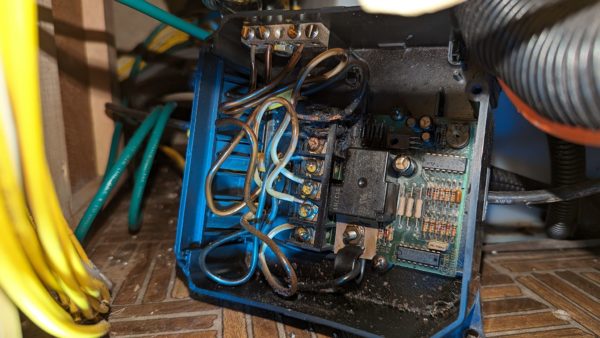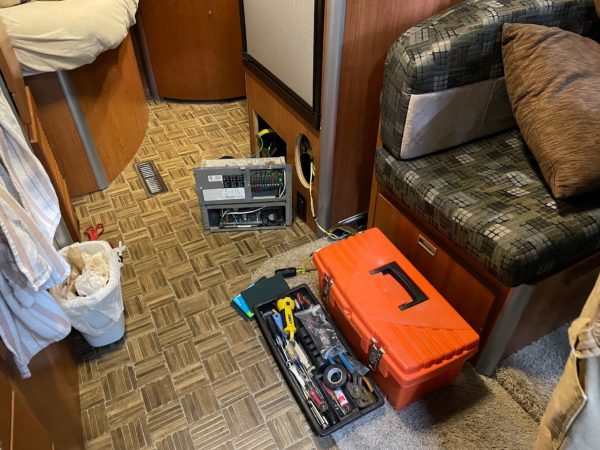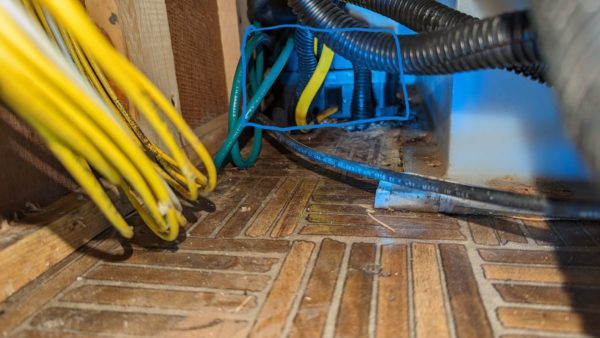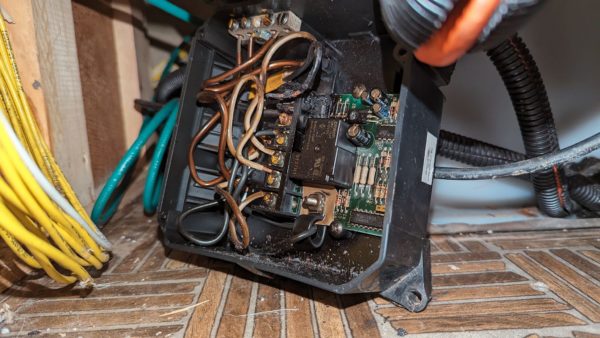
The parts wear out and sometimes break or fail. The reason I bring this up is that we’d noticed odors emanating from the space below our refrigerator on a few occasions. These odors smelled like something getting hot and they seemed to correlate with operation of the microwave or the electric heating element in the water heater. Hmm…
Coincidentally, mounted in the wall below the refrigerator in our vehicle there is a power center which contains 1) a 120VAC panel with breakers for outlets, microwave/convection oven, water heater, roof-mounted A/C and heat pump, and the 12V converter/chatger; 2) a converter that converts 120VAC to 12VDC to power the 12V components when we’re plugged in to “shore power” (LED lights, water pump, control boards for the gas water heater, gas refrigerator, gas furnace, kitchen & bath exhaust fans, a handful of USB charging outlets we added, and a TV; and 3) a charger built in to the converter that charges a pair of golf cart batteries to run the 12V systems when we don’t have shore power. [TLDR: Anything that involves electricity in our motorhome’s living space starts out in that space under the refrigerator – the one where the burning smell was coming from.]
Before leaving home, I spent some time looking around in that space and checked over the power center for obvious problems. I found and removed an abandoned mouse nest that was blocking a cooling fan on the side of the converter. This could explain a foul odor that would become noticeable when things got warm down there, although the converter doesn’t have anything to do with the microwave or the water heater. Otherwise, close inspection of the converter/charger/breaker panel inside the power center showed no signs of problems, no loose connections or overheating. Peering back as far as I could see into the jumble of wires behind the electrical box revealed nothing obvious beyond a few more signs of the rodent visitors, and it seemed this residual detritus could have been responsible for the odors. We tested the microwave oven again before our departure. It successfully brought water to a boil, didn’t create any smells, and things were looking good.
A few days into our trip, we were running the water heater on electricity and noticed “that smell” for the first time on this trip. A little later we were using the microwave when it sputtered and flickered and went dark and a powerful burning smell came from under the refrigerator. As I opened up the power center, nothing in the electrical box was warm, no issues there to be found, but there was definitely something hot back there somewhere. From an online forum for owners of 2008-2010 Winnebago Views (like ours), I learned that 1) the microwave and the water heater share the same breaker and 2) there is an “Automatic Energy Selector” switch that controls power to the microwave and the water heater, allocating power between them with priority to the microwave, to allow these two high-load appliances to share a single 20A circuit. Hmm…
I’d never noticed this switch nor read about it in the manual. From downloaded wiring diagrams, I learned that ours is installed somewhere behind that power center in the space under the refrigerator – where the smell was coming from. Hmm…
The switch box was not easy to locate nor to reach, but I did find it back there, screwed down to the floor under jumbles of wiring, just aft of the box that contains the electrical hookups, all the way in the back of the under-fridge compartment near the outside wall. After pulling the power center completely out from the wall, I could reach in to access two of the four hold-down screws on the switch box. I could get to the other two by taking apart the vanity to the left of the refrigerator and reaching through the side wall into the space under the refrigerator from behind. I got the switch box up from the floor, took the cover off, and shuddered a bit at what I found in there.
The connection for the hot wire from the breaker had been loose. A loose connection causes high resistance where there should be none. High current in a high resistance connection like that causes heat – in our case, enough heat to melt the plastic case and turn the material around the bad connection to charcoal. See the photos below, and a few more in this flickr album.






We were lucky that nothing outside of the box caught fire. The burnt switch is now gone, and with it went the smell (yay!). I temporarily wired the microwave directly to the breaker, and I disconnected the line to the water heater (which we can still run on propane). This should eliminate the potential for overheating (phew!). I also, belatedly, gave the under-fridge area a proper cleaning to get rid of the rodent residue (so if something ever does heat up back there, at least it won’t smell like burning mouse shit).
When we’re back from this trip, I may replace the failed automatic switch with a manual switch (we don’t often use the electric water heater). Otherwise, the original switch is still available so maybe I’ll just get a new one. Either way, I will relocate the new switch to another compartment on the other side of the rig from the original location. This compartment has an easily removable cover panel so we can access the switch to check the connections (or reach it with a fire extinguisher – just sayin’). The microwave is up above this compartment and the water heater is in the back of it, and the existing cables for both already run through there from the power center, so I can repurpose one of those to supply the power from the breaker to the switch. The rest should be pretty simple.
